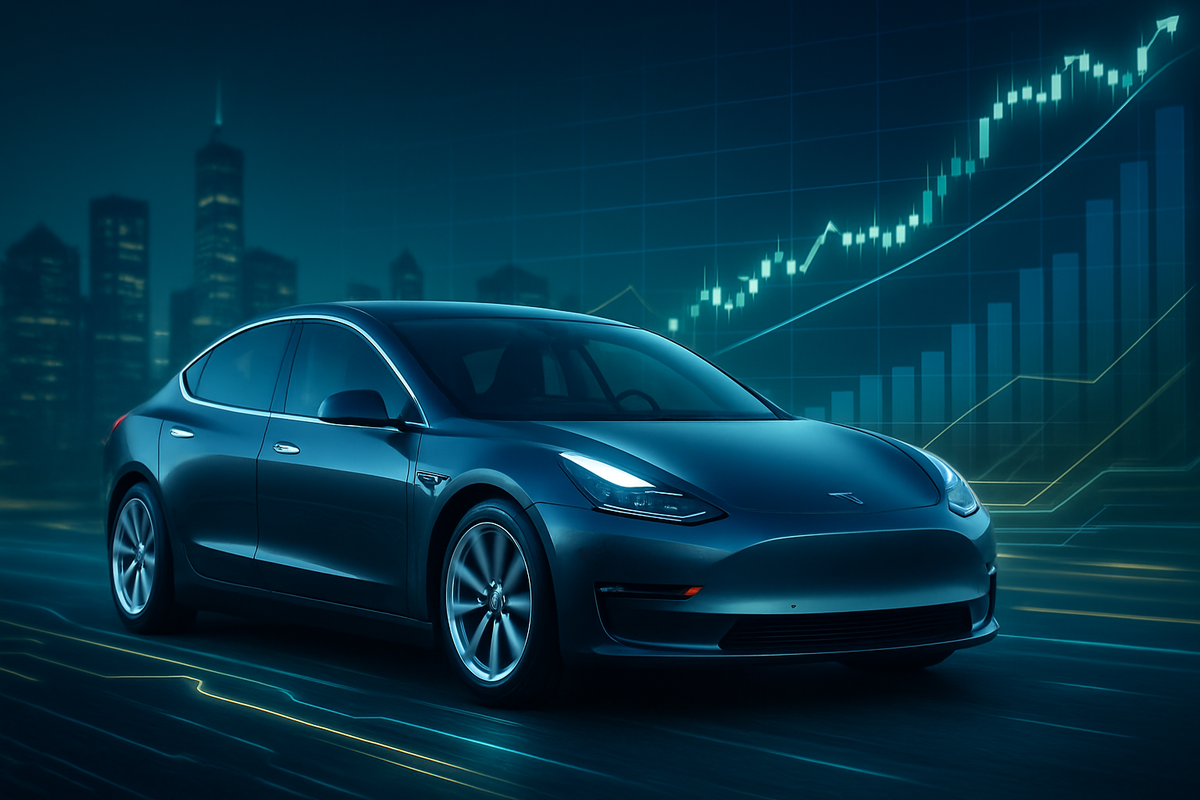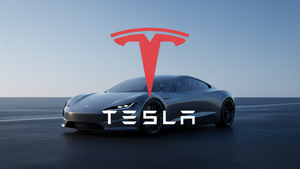
On October 2nd, 2025, electric vehicle giant Tesla (NASDAQ: TSLA) announced an unprecedented third quarter for vehicle deliveries, significantly surpassing even the most optimistic projections from Wall Street. This remarkable achievement immediately triggered a substantial rally in Tesla's stock, sending shares to new 2025 highs and pushing the company's market capitalization beyond $1.5 trillion. The robust delivery figures underscore a surge in consumer demand, partly fueled by the impending expiration of federal EV tax credits and strong sales performance across critical international markets.
This record-breaking quarter marks a pivotal turnaround for Tesla, following two consecutive quarterly declines in the first half of 2025. The strong performance not only reaffirms the company's dominant position in the rapidly expanding electric vehicle sector but also sets a high bar for competitors navigating a dynamic market landscape. Investors are now keenly awaiting the full Q3 2025 financial results, scheduled for October 22nd, which will provide deeper insights into the company's profitability and operational efficiency amidst this period of accelerated growth.
Record Deliveries Propel Tesla to New Heights
Tesla’s third-quarter performance for 2025 was nothing short of spectacular, with the company delivering an all-time high of 497,099 vehicles worldwide. This figure represents a robust 7.4% increase from the same period last year and comfortably outstripped Bloomberg consensus estimates of 439,612, as well as higher analyst forecasts that ranged up to 480,000 units. The Model 3 and Model Y continued to be the bedrock of this growth, accounting for 481,166 units, while "Other Models," including the premium Model S, Model X, the much-anticipated Cybertruck, and the Tesla Semi, saw a significant 53% quarter-over-quarter jump to 15,933 units.
While deliveries surged, Tesla's production figures told a slightly different story, with 447,450 vehicles produced during the quarter. This marked a 4.8% decline from the previous year and was marginally below the consensus of 450,313. However, the substantial beat in deliveries despite a slight production dip suggests highly efficient inventory management and a successful strategy to clear existing stock. Beyond vehicles, Tesla also showcased the growing strength of its energy business, reporting a record 12.5 GWh of energy storage product deployments, highlighting the expanding strength of its energy business.
The immediate market reaction was decisively bullish on October 2nd, 2025. Tesla’s stock (NASDAQ: TSLA) surged between 3.5% and 4% in early trading, cementing its position as a market leader. Analysts largely attributed this stellar delivery performance to a significant "pull-forward" of demand in the United States, as consumers rushed to capitalize on the $7,500 federal EV tax credit before its expiration on September 30, 2025. Furthermore, improved sales performance across key international markets, including Europe, China, Turkey, and South Korea, played a crucial role in bolstering these record numbers. This turnaround follows a challenging first half of 2025, where the company experienced two consecutive quarterly declines in deliveries, making the Q3 results a significant vindication of its strategic adjustments and market appeal.
Market Winners and Losers in the Wake of Tesla's Triumph
Tesla's (NASDAQ: TSLA) exceptional Q3 delivery performance unequivocally positions the company as a major winner in the current financial landscape. The stock surge on October 2nd, 2025, translates directly into increased shareholder value and enhanced investor confidence. This strong showing provides Tesla with significant momentum heading into the final quarter of the year, potentially reinforcing its valuation and attracting further investment. The ability to exceed delivery expectations, particularly after a challenging first half, demonstrates the company's resilience, operational efficiency, and sustained brand appeal, enabling it to command a premium in the market despite competitive pressures.
On the other hand, traditional automakers and emerging EV startups, while not directly "losing" in an absolute sense, face intensified pressure. Companies like General Motors (NYSE: GM), Ford (NYSE: F), Volkswagen (XETRA: VOW3), and numerous smaller EV players are constantly vying for market share. Tesla's robust quarter raises the bar for the entire industry, forcing competitors to accelerate their own EV production, innovation, and delivery capabilities to remain competitive. A strong Tesla performance can lead investors to favor the established EV leader, potentially diverting capital and attention away from rivals struggling to scale production or meet their own ambitious targets. This heightened competition could impact their stock performance or future fundraising efforts.
Furthermore, the "pull-forward" of demand due to the expiring U.S. federal EV tax credit, while beneficial for Tesla in Q3, might create a tougher selling environment for all EV manufacturers in Q4 2025 and early 2026. Companies heavily reliant on these incentives might see a significant dip in sales as consumers no longer have the same financial motivation. This scenario could particularly affect newer entrants or those with less established brand loyalty, as they might struggle to differentiate their offerings without the added incentive. The market dynamics shift, putting greater emphasis on product innovation, pricing strategy, and charging infrastructure, areas where Tesla currently holds a significant advantage.
Wider Implications and Industry Ripple Effects
Tesla's stellar Q3 2025 delivery figures are more than just a win for the company; they signify broader trends within the electric vehicle industry and the global economy. The robust demand, particularly for the Model 3 and Model Y, underscores the accelerating consumer adoption of EVs, driven by increasing environmental awareness, technological advancements, and a growing charging infrastructure. The impact of the expiring $7,500 federal EV tax credit in the U.S. also highlights the significant role government incentives play in shaping market demand, creating both opportunities and potential volatility as policies evolve. This event serves as a crucial data point for policymakers worldwide, demonstrating the immediate market response to such financial stimuli.
The ripple effects on competitors are substantial. While Tesla (NASDAQ: TSLA) basks in its success, other automakers are compelled to reassess their own EV strategies and production timelines. Traditional giants like Mercedes-Benz (ETR: MBG), BMW (ETR: BMW), and Hyundai (KRX: 005380), alongside newer pure-play EV companies such as Rivian (NASDAQ: RIVN) and Lucid (NASDAQ: LCID), face increased pressure to innovate, optimize production, and expand their market presence. Tesla's ability to achieve such high delivery volumes, even with a slight dip in production, emphasizes the importance of efficient logistics and supply chain management, lessons that competitors are undoubtedly scrutinizing. This competitive intensity is likely to spur further price competition and technological advancements across the board.
From a broader perspective, Tesla's continued dominance reinforces the shift towards sustainable transportation and energy solutions. The record deployment of energy storage products further highlights the company's strategic vision beyond just vehicles, positioning it as a key player in the wider energy transition. Historically, companies that successfully scale innovative technologies, much like early internet or mobile phone pioneers, often achieve sustained market leadership. However, the automotive industry is cyclical and highly competitive. Concerns raised by analysts, such as Tesla's premium valuation (118 times its 2026 EBITDA estimate) compared to tech peers, increasing geopolitical exposure in China, and "key-man risk" associated with CEO Elon Musk, serve as reminders that even market leaders face significant challenges and scrutiny.
The Road Ahead: Navigating Future Opportunities and Challenges
Looking ahead, the immediate focus for Tesla (NASDAQ: TSLA) and the broader market will be on the company's Q4 2025 performance. While Q3 was exceptionally strong, analysts, including UBS, anticipate a sequential drop in deliveries for the final quarter of the year. This expected decline is primarily attributed to the fading impact of the expired $7,500 federal EV tax credit in the United States, which significantly pulled forward demand into Q3. Tesla will need to demonstrate sustained organic growth and successful market penetration in other regions to offset this anticipated domestic slowdown. The upcoming full Q3 2025 financial results, due after market close on Wednesday, October 22, 2025, will be crucial, providing detailed insights into profit margins, operational costs, and the overall financial health of the company.
In the long term, Tesla faces both significant opportunities and formidable challenges. The continued global push for electrification presents a vast addressable market for its vehicles and energy solutions. Potential strategic pivots could involve further expansion into new geographical markets, accelerating the rollout of its FSD (Full Self-Driving) technology, and potentially introducing new, more affordable vehicle models to capture a wider consumer base. The Cybertruck and Tesla Semi's ramp-up will also be closely watched as they represent new revenue streams and market segments. However, the landscape remains intensely competitive, with traditional automakers pouring billions into their EV divisions and new startups constantly emerging.
Market opportunities may arise from advancements in battery technology, further integration of AI into vehicle systems, and the expansion of charging infrastructure, all areas where Tesla is a key innovator. Conversely, challenges include managing supply chain complexities, navigating geopolitical tensions that could impact production and sales, and addressing regulatory hurdles in different jurisdictions. The "key-man risk" associated with Elon Musk's multifaceted ventures also remains a point of consideration for investors. Potential scenarios range from continued market dominance through relentless innovation to increased market share erosion if competitors successfully close the technology and production gap. Investors will be keenly watching for signs of sustainable growth beyond incentive-driven demand.
Comprehensive Wrap-up and Investor Outlook
Tesla's (NASDAQ: TSLA) record-breaking Q3 2025 deliveries represent a significant triumph, effectively reversing earlier quarterly declines and reaffirming the company's leading position in the global electric vehicle market. The surge in deliveries, driven partly by the expiring U.S. federal EV tax credit and strong international sales, propelled Tesla's stock to new 2025 highs, pushing its market capitalization beyond $1.5 trillion. This performance underscores robust consumer demand for EVs and Tesla's operational prowess in managing inventory and fulfilling orders efficiently. The key takeaway is Tesla's resilience and ability to capitalize on market dynamics, even in a highly competitive environment.
Moving forward, the market will assess Tesla's ability to maintain momentum in Q4 2025, particularly as the "pull-forward" effect of the U.S. tax credit subsides. The upcoming Q3 financial results on October 22nd will provide critical insights into profitability and margins, especially given the slight dip in production despite soaring deliveries. While Tesla remains a dominant force, the landscape is evolving rapidly, with increasing competition from both legacy automakers and new EV entrants. The company's premium valuation, geopolitical exposure, and reliance on its charismatic CEO will continue to be subjects of scrutiny for investors.
For investors, the coming months will require close attention to several factors. Beyond Q4 delivery numbers, watching Tesla's gross margins, capital expenditure, and progress on new product ramps (like the Cybertruck) will be crucial. Any strategic announcements regarding new factories, battery technology advancements, or expansions into new markets will also be significant. Furthermore, monitoring the broader EV market trends, competitor performance, and global economic indicators will provide context for Tesla's trajectory. While Q3 was a resounding success, the path ahead demands continuous innovation, efficient execution, and strategic adaptability to sustain its market leadership.
This content is intended for informational purposes only and is not financial advice.





